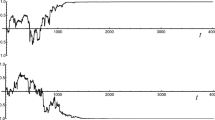Summary
In a recent paper,Ellis,Hagelin,Nanopoulos andSrednicki, motivated by Hawking’s analysis of the breakdown of predictability in gravitational collapse, have proposed a modified equation of motion for density matrices and checked it against upper bounds for the violation of quantum mechanics in various phenomenological situations. Difficulties arising in this model have been pointed out by Banks, Susskind and Peskin. A general feature of this approachi s that the correspondence between symmetries and quantum-mechanical conservation laws is lost. On the other hand, in the case of a specific model, in which rotational invariance is preserved, but conservation of quantum-mechanical angular momentum is released, we show that the modified evolution equation exhibits irreversible evolution of pure states into mixed states of maximal entropy. Consequences of our approach concerning some views about Bell’s theorem are also discussed.
Similar content being viewed by others
References
S. W. Hawking:Phys. Rev. D,14, 2460 (1976).
R. M. Wald: Black holes, thermodynamics and time reversibility, inQuantum Gravity II, edited. by C. J. Isham, R. Penrose and D. W. Sciama (Oxford University Press, Oxford, 1981);
S. W. Hawking:Commun. Math. Phys.,87, 395 (1982);
D. N. Page:Gen. Rel. Grav.,14, 299 (1982);
F. J. Tipler:Gen. Rel. Grav.,15, 1139 (1983); and references therein.
J. Ellis, J. J. Hagelin, D. V. Nanopoulos andM. Srednicki:Nucl. Phys. B,244, 125 (1984).
T. Banks, L. Susskind andM. E. Peskin:Nucl. Phys. B,244, 125 (1984).
G. G. Emch andG. L. Sewell;J. Math. Phys. (N.T.),9, 946 (1968).
V. Gorin:,A. Frigerio, M. Verri, A. Kossakowski andE. G. G. Sudarshan:Rep. Math. Phys.,13, 149 (1978).
R. M. Wald:Phys. Rev. D,21, 2742 (1980).
A. Baracca, D. J. Bohm, B. J. Hiley andA. E. G. Stuart:Nuovo Cimenio B,28, 453 (1975).
A. R. Wilson, J. Lowe andD. K. Butt:J. Phys.,42, 613 (1976).
D. J. Bohm andB. J. Hiley:Nuovo Cimenio B,35, 137 (1976).
R. Balian,Du microscopique au macroscopique, Tome I (Ecole Polytechnique, Ellipses, Paris, 1982), p. 104.
C. Kittel:Elementary Statistical Physics (New York, N. Y., 1938), p. 169.
Author information
Authors and Affiliations
Rights and permissions
About this article
Cite this article
Bergia, S., Cannata, F., Giorgini, B. et al. A solvable model for irreversible quantum phenomena. Lett. Nuovo Cimento 43, 113–118 (1985). https://doi.org/10.1007/BF02749588
Received:
Published:
Issue Date:
DOI: https://doi.org/10.1007/BF02749588




